| Glorious Wiki readers. We are adding the Midnight Magic video and livestream to the wiki. We appreciate your patience as we process the new and updated information! |
Difference between revisions of "Progression"
(Change link) |
(Split templates) |
||
| Line 3: | Line 3: | ||
Leveling won't follow a traditional linear path, although classic mechanics for leveling exist.<ref>[[File:leveling.png|350px]]</ref> Repetition will not be part of progression in [[Ashes of Creation]].<ref name="grind">[[File:quests grind.png|350px]]</ref> | Leveling won't follow a traditional linear path, although classic mechanics for leveling exist.<ref>[[File:leveling.png|350px]]</ref> Repetition will not be part of progression in [[Ashes of Creation]].<ref name="grind">[[File:quests grind.png|350px]]</ref> | ||
| − | == | + | == Class progression == |
| − | {{Classes | + | {{Class progression}} |
| + | |||
| + | === Classes by archetype combination === | ||
| + | |||
| + | {{Classes by archetype combination}} | ||
| + | |||
| + | === Class abilities === | ||
| + | |||
| + | {{Class abilities}} | ||
| + | |||
| + | == Artisan progression == | ||
| + | |||
| + | {{Artisan progression}} | ||
| + | |||
| + | == Node progression == | ||
| + | |||
| + | {{Node advancement}} | ||
| + | |||
| + | === Node development === | ||
| + | |||
| + | {{Node development}} | ||
| + | |||
| + | == Guild progression == | ||
| + | |||
| + | {{Guild progression}} | ||
| + | |||
| + | == Social organization progression == | ||
| + | |||
| + | {{Social organization progression}} | ||
| + | |||
| + | == See also == | ||
| + | |||
| + | * [[Archetypes]] | ||
| + | * [[Combat]] | ||
{{Notes}} | {{Notes}} | ||
[[Category:Player agency]] | [[Category:Player agency]] | ||
Revision as of 17:23, 22 October 2017
| This article is currently incomplete. Help us by expanding it. |
Leveling won't follow a traditional linear path, although classic mechanics for leveling exist.[1] Repetition will not be part of progression in Ashes of Creation.[2]
Class progression
Class progression in Ashes of Creation proceeds as follows:[3]
- Players receive skill points as they level. These can be used to level up skills within their skill tree.[8]
- It will not be possible to max all skills in a skill tree.[8]
- A player may choose a secondary archetype when they reach level 25.[3][4] The combination of primary and secondary archetypes is referred to as a class.[4][7][9]
- The secondary archetype does not provide additional skills.[10]
- Secondary archetypes may be changed, but not "on-the-fly".[6][11]
- The player can then augment their primary skills with effects from their secondary archetype.[4][5]
- Class progression does not relate to a player's artisan progression.[12]
- World events do not directly impact class effectiveness but there may be ancillary effects in terms of availability of equipment, enchantments or tattoos.[13]
Classes by archetype combination
With 8 Archetypes to combine, players may choose from 64 total combinations to create their class.[4][7][9]
Class abilities

If from the eight archetypes whatever you choose as your secondary, you're going to receive a choice of augments that relate to some core ideal of that class. You know like a tank is about controlling the battlefield, is about surviving. The mage is about dealing damage and elements and ability in AoEs. The rogue is going to be about stealth and critical damage. So those augments are going to to play towards those identities.[15] – Steven Sharif
The idea behind the system is that you're skirting the line through these augmentations of your role, right. We have the traditional holy trinity that's present in class designs for MMOs and it's often that those either are not deviated at all or completely deviated from entirely. The augment is to offer a balance between that where you still maintain the semblance of that trinity system while offering the opportunity to customize your play experience towards one of the other angles in the triangle.[16] – Steven Sharif
Primary skills (class abilities) are based on a player's archetype.[17][5]
- A player may choose a secondary archetype when they reach level 25.[3][4] The player can then augment their primary skills with effects from their secondary archetype.[17][3][4][5][18]
- Outside of class-specific skills there may be a subset of universal skills, such as active block and dodge.[19]
- Class skills are not affected by the type of weapon that is equipped.[20]
- Primary skills in Alpha-2 are expected to be very different to those in Alpha-1.[21]
Artisan progression
| Artisan level | Artisan certification | Profession limit per character |
|---|---|---|
| 1-10.[25][26] | Novice.[22][27] | 22.[22][23] |
| 10-20.[28][26] | Apprentice.[22] | 5.[22][23] |
| 20-30.[28] | Journeyman.[22][24] | 4.[22][23] |
| 30-40.[28] | Master.[22][24] | 3.[22][23] |
| 40-50.[28][29] | Grandmaster.[22][24] | 2.[22][30][23] |
Artisan progression occurs based on experience (repetition of tasks) as well as achievements of certain benchmarks within each artisan branch (Gathering, Processing and Crafting).[32][33] Progression in each artisan profession is per-character.[34][35][36][37]
- All 22 professions, the players get to be novice of; and then it starts narrowing from there. So, after that you'll only be able to be apprentice of five things. You can be a journeyman in four things. You can be a master in three things; and you can be a grandmaster in two things. So you'll need to narrow, but you can also diversify to support the professions that you want to first push further in.[23] – Kory Rice
- Progression to each "tier" within a profession grants skill points that can be utilized in a character's artisan skill tree.[39]
- Artisan certification quests must be completed to gain proficiency in that tier of artisan progression.[32] Completing certification unlocks benefits for that profession, such as artisan tools for gathering professions and recipes for crafting professions.[40][41]
- There are limits to the number of professions at each certification tier across the three artisan branches.[22][30][42][23][43] For example: a character may only ever be a Master in up to 3 professions and Grandmaster in up to 2 professions across all artisan branches.[22][30]
- Grandmaster artisans can max out their entire profession skill tree, but a character can only be a grandmaster of up to two professions.[44]
- Achieving an artisan certification in a profession also implies that the character also achieved any lower-tier certifications up to that point.[45]
- If you are grand master in that profession you can max out the entire tree. But you can only grand master 2 things.[44] – Kory Rice
- Choosing a specific path in the skill tree allows the player an opportunity to specialize in a certain area. This encourages player inter-dependency, enhancing the artisan experience.[46]
- Progression within artisan classes does not directly relate to progression in a character's adventuring class, but there are requirements that take into account dangers, locations, toolsets, and surveying options that are dependent on adventuring level.[47][48][12]
- Characters gain XP as they progress their professions.[49][41]
- It should be expected that some artisans will have significantly higher artisan level than their adventuring level.[49][47]
- Q: In regards to character level and artisan level. We know that currently there are two separate things. That being said, what prevents a player from staying level one and partying up with a level 50 player to then gather level 50 resources in the high zones? That way, anyone who wants to take those resources will have to kill the gatherer who is level one and get a large amount of corruption for killing a level one as a level 50.
- A: Gathering higher level resources requires significant advancement within a particular profession for that gatherable resource. So, if I'm a Miner and I want to access the highest possible mineral, I need to be a master miner; and in order to achieve the master minor status I am going to be gaining adventuring level experience through that process, because many of those quest lines, many of those achievements are facilitated through quest lines. Some of those quest lines interface with adventuring difficulties that are out in the wild at certain levels. So that's going to predicate me- that's going to be a predicate for me to achieve a certain level in order to complete some of these quest lines and achieve that master status. So you will you will likely not see the ability of a level one alt character having the access to high level mineral mining, or any other type of gatherable out there.[47] – Steven Sharif
Node progression
Citizen and non-citizen player activity (questing, gathering, raiding, etc.) within a node's ZOI counts toward that particular node's advancement (progression) to a higher node stage.[51][52]
The advancement of a node unlocks its unique content, which comes at the cost of locking out an increasing ring of neighboring nodes from progressing to the next stage.[53]
- Nodes advance to the first stage quickly. This enables NPC services such as vending or banking items.[54]
- The more advanced the node is, the larger its ZOI becomes.[55]
- Less advanced nodes (referred to as vassal nodes) that fall within a more advanced node's ZOI can still gain XP, but must remain at a lower advancement stage than the dominant node.[56]
- The vassal system begins when a node hits Village (stage 3), but neighboring nodes starting from Expedition (stage 1) also block the growth of their immediate neighbors.[57][58]
- Certain quests, such as story arcs, may not be able to be turned in after a node has advanced.[59]
- The territory expansion algorithm takes into account the nearest coast, neighboring nodes, and the heatmap of players in surrounding areas over the last weeks or month.[60]
- Due to the way the progression algorithm calculates territorial (ZOI) expansion during node advancement, there is a small possibility that two nodes of the same stage end up being close to each other.[61]
- The way that the algorithm expands the territories takes into account a few things: One it takes into account the coast like where's the closest coast. Two it takes into account the neighboring nodes so it can take over and essentially vassal state those nodes, but what's more important is essentially the initial population based on like how players choose their races. Because we have nine different races and four different starting points that branch out, each server's population density is going to dictate essentially the first few nodes that are highly populated and then that initial seed is what's going to determine the node structure as it moves inland into the into the world essentially; and based on the performance and successes of different sieges will determine which nodes that got locked out from the previous the initial advancements what nodes can now be available to advance further. So I really think that with so many variables that are present in the equation of how nodes advance and stay existing with the more variables you have, the higher likelihood there is for there to be a significant diversion in world progression.[60] – Steven Sharif
- Normally the algorithm that's applied to the node territorial expansion will prevent significant nodes from being in close proximity to each other... There could be a perfect storm where all of the algorithmic progression of territory leads to having these nodes very close to each other because there's certain requirements that should that need to be available to satisfy node vassal takeovers; and it's possible that two nodes would never take each other over as vassals and end up close together and spanning their territories in opposite directions: The Tale of Two Cities thing.[61] – Steven Sharif
- A node does not receive XP from the nodes within its ZOI until these nodes have reached their cap.[56]
- Node experience gain opportunities will be equitable across the four node types.[63]
- Different people have different resources invested in nodes progressing and it would be a little "gamey" if you could know exactly what was necessary at that point because that would disincentivize people from participating.[64] – Steven Sharif
Node advancement spawns a series of animations and visual effects (within the footprint of the node).[65][51]
- Players within the node are teleported to a safe location, likely a respawn area near the node.[65][66]
- Supplies will spawn around the node and system driven caravans are spawned to bring these supplies into the node. These caravans are not able to be attacked.[65]
- NPCs will begin construction activities.[65]
- Players outside the node will see the new facade of the node pop into existence as the node advances in stage.[65]
- The Development Area of a Node is where civilization will appear as the Node advances. As the Node Stage increases, different buildings, NPCs, and services will become available in the Development Area. The higher the Node Stage, the more complex and populated the Development Area becomes. Development Areas will also vary depending on the Node Type - Economic, Military, Scientific, or Divine.[51] – Margaret Krohn
Node development
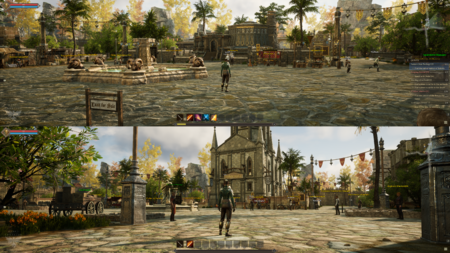
The layout and architecture within a Node’s development area are determined by influential race. For example, a stage 3 Node with the majority of player contribution being Py'rai would have a Py'rai village with Py'rai architecture. Most NPCs would be Py'rai elves, and offer questlines within the Py'rai narrative.[67] – Margaret Krohn
Each player’s contributed experience is flagged with their character race and other identifiers. When a Node advances, the race with the highest experience contribution determines the Node’s style and culture. This style and culture change can happen at every Node Stage. For example, if a Node advances to Level 2 - Encampment Stage and 51% of all experience was earned by Ren’Kai players, the Node will be a Level 2 Ren’Kai Node. If that same Node advances to a Level 3 - Village Stage Node, but the Py'Rai contributed 62% of all the experience earned, then the Node will be a Level 3 Py'Rai Node.[51] – Margaret Krohn
Node layout and style is determined by several factors:[68][69]
- The way that the node system is built is that they can exist across a spread of 18 biomes, but at the same time have to represent the cultural influence of these cultures that are intrinsically a part of a specific biome.[70] – Steven Sharif
- Environment (biome) and location of the node.[70][68][69]
- Nodes will adjust the local topography to fit the aesthetic and mechanical requirements of the node.[71]
- Currently the way that the platform system is set up, is it's capable of adjusting the topography of the node's footprint, regardless of the surrounding terrain. So the reason for that is we want to have flexibility in the presentation of the node's layout and how it is essentially both from an aesthetic standpoint as well as a mechanical standpoint with node sieges- how it's constructed and that construction should have the ability to take on a variance of different types of topography. So it shouldn't be dependent on the surrounding area. Now that's not to say that the surrounding area isn't going to have some influence over. So for example... we're experimenting a little bit with the platform tech and putting up a node up against the side of a mountain or on the edge of a cliff or something that has a beautiful vista. Those are things that we're going to test out obviously as we continue to work on the node tool and how that platform system works, but the idea is to have the node independent of the surrounding terrain.[71] – Steven Sharif
- Some parts are determined by the area it's in. Some parts are determined by the type it is. Some parts are determined by the race it is; and then the rest of it is determined by the mayor.[69] – Jeffrey Bard
- Race that contributed the highest percentage to the node's advancement will alter the racial appearance of its buildings, NPCs, and props.[72][73][68][51][69][74][75]
- All nodes, whether they're associated with a castle or associated with normal node structure, has cultural influences that replicate over to the buildings that are produced and the NPCs that are present.[77] – Steven Sharif
- The rest is determined by the node's mayor.[69]
- It should be possible for a node to complete several building projects within a mayor's one month term in office.[78]
- Q: How long would you say it will take players on average to fill/build up a node completely from wilderness to metropolis?
- A: It's one thing to get a node to a certain level: it's another thing to develop the node; and I can't really give you an on-average expectation, because there's a lot of variables at play. There's how many citizens does the node have attracted to it; what's the type of traffic that the node is attracting to it based on things like its tax rates, or the specialization that it chose to spec into, based on the building types it's chosen to build. All of those things are variables that can affect the quote-unquote "average build-out time" of a particular node. So it's difficult to give you an average when there's so many variables along those lines. But the idea is that if there is a particular project that players are interested in in developing based on the node stage, that they would have the ability to complete several of those projects as within a single term of a mayor; and a term of a mayor is one month.[78] – Steven Sharif
Guild progression
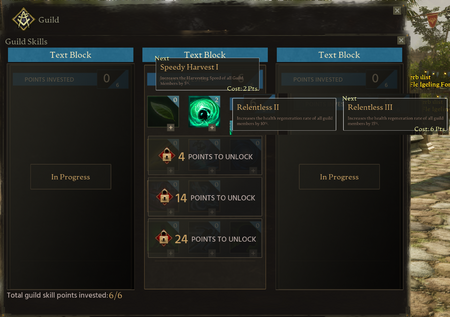
As you're leveling up the guild and you're getting these points to either allocate towards expanding the guilds member count or allocate towards adding certain passive abilities that your guild members can gain by being guild members. You're also going to see as you're leveling up the guild through different type of quest-based, participation-based, node-based, organization-based systems and ways that those quests hook into the world. You're also going to see perhaps some augment abilities at the upper tiers of the guild levels become unlocked for certain members that have a classification of officer or knight, will have access to those different types of augment abilities that might get unlocked should you go down the non expansive member lane; and the idea there is to offer these benefits to smaller groups.[79] – Steven Sharif
Guild progression occurs through participation in different systems.[79]
Guild progression grants skill points that the guild can allocate to unlock aspects of their skill tree, such as passive skills, augments and membership count.[79][81][82]
- Passive abilities increase certain stats relating to a guild member's ability to perform in combat or in other aspects of the guild, such as the economy.[79]
- Augments may apply at the upper tiers of guild progression.[79]
- Guild members do not need to be citizens of the same node in order to benefit from passive skills and augments.[83]
- Guild size can be traded off for guild progression.[79][84]
- The higher the guild's member cap, the fewer available skill options will be available to that guild.[85]
- Guild alliances may be a key part in creating a larger "guild".[84]
- Guild halls can be unlocked at a certain stage of guild advancement.[81]
- Guilds cannot respec their skill points once allocated. This is subject to testing.[86]
- It's not always going to be combat. You could have an economic focus guild. You could have a trade oriented guild; and there's all sorts of things that you can put together and give your guild its own identity.[79] – Jeffrey Bard
Social organization progression
Social organization progression is achieved through accomplishing tasks or quests within that social organization.[87]
- Some progression is static, but more competitive achievements will be seasonal, based on a ladder system.[88]
There are hierarchical paths pertaining to specific questlines for the organization's thematic.[87] These quests will either be cooperative with or adversarial against other nodes based on their mutual war status.[89]
- - For example, a Thieves' guild may have objectives and quests toward securing a particular item to enable players to advance within the organization.[87]
- Social organizations are going to have questlines that players participate in which some will include sabotage, espionage, intrigue... While it's not necessarily player versus player in the combat sense, it is player versus player in pitting communities in those organizations against each other in a competitive atmosphere, where only some things can be accomplished by certain communities; and not everybody can succeed at a particular task. So, I think that that's a unique way to involve meaningful conflict that doesn't necessarily have to relate to PvP, because obviously we have a lot of PvP systems in the game and and there are many ways for players to participate in player versus player combat; but we also want to make sure that from a progression standpoint, from a system standpoint there are going to be abilities of individuals to follow these questlines, these tasks that will pit organizations against each other, specifically from an organizational standpoint.[90] – Steven Sharif
See also
References
- ↑

- ↑ 350px
- ↑ 3.0 3.1 3.2 3.3 Livestream, July 28, 2023 (1:04:27).
- ↑ 4.0 4.1 4.2 4.3 4.4 4.5 4.6 Interview, July 18, 2020 (1:05:04).
- ↑ 5.0 5.1 5.2 5.3

- ↑ 6.0 6.1 Interview, July 29, 2020 (54:44).
- ↑ 7.0 7.1 7.2 Ashes of Creation class list.
- ↑ 8.0 8.1 Livestream, July 28, 2017 (19:05).
- ↑ 9.0 9.1

- ↑ Livestream, May 3, 2017 (50:50).
- ↑ Livestream, July 18, 2017 (37:43).
- ↑ 12.0 12.1 Livestream, July 31, 2020 (1:31:11).
- ↑ Podcast, April 11, 2021 (54:35).
- ↑
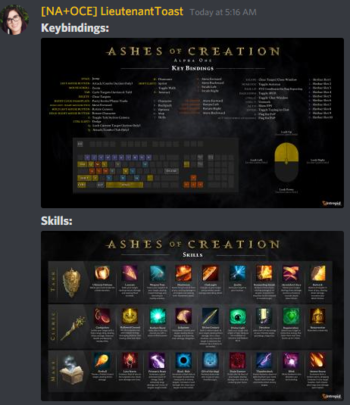
- ↑ Livestream, October 16, 2017 (1:00:44).
- ↑ Interview, August 8, 2018 (22:27).
- ↑ 17.0 17.1 Livestream, December 19, 2023 (1:20:41).
- ↑

- ↑ Livestream, November 19, 2021 (50:38).
- ↑ Video, September 30, 2022 (17:00).
- ↑ Livestream, September 24, 2021 (1:18:06).
- ↑ 22.00 22.01 22.02 22.03 22.04 22.05 22.06 22.07 22.08 22.09 22.10 22.11 22.12 22.13

- ↑ 23.0 23.1 23.2 23.3 23.4 23.5 23.6 23.7 23.8 23.9 Video, November 30, 2023 (37:12).
- ↑ 24.0 24.1 24.2 24.3 Development Update with Freehold Preview.
- ↑

- ↑ 26.0 26.1 Video, November 30, 2023 (9:36).
- ↑ Livestream, June 30, 2023 (50:07).
- ↑ 28.0 28.1 28.2 28.3 Podcast, December 3, 2023 (14:14).
- ↑ Podcast, December 3, 2023 (2:53).
- ↑ 30.0 30.1 30.2
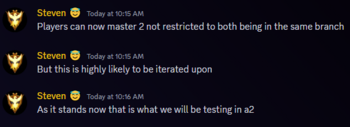
- ↑ Video, November 30, 2023 (23:20).
- ↑ 32.0 32.1 Video, November 30, 2023 (16:40).
- ↑ Interview, February 7, 2021 (36:38).
- ↑

- ↑ Livestream, April 29, 2022 (1:13:00).
- ↑ Livestream, July 26, 2019 (1:09:46).
- ↑ Livestream, May 24, 2017 (32:07).
- ↑ Podcast, December 3, 2023 (10:22).
- ↑ Video, November 30, 2023 (26:38).
- ↑ Podcast, December 3, 2023 (17:10).
- ↑ 41.0 41.1 Video, November 30, 2023 (36:00).
- ↑
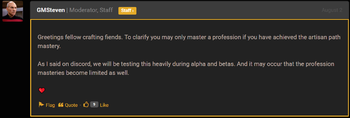
- ↑

- ↑ 44.0 44.1 Podcast, December 3, 2023 (6:23).
- ↑

- ↑ Livestream, May 10, 2017 (6:12).
- ↑ 47.0 47.1 47.2 Livestream, April 7, 2023 (1:00:55).
- ↑ Livestream, October 28, 2022 (1:32:38).
- ↑ 49.0 49.1 Podcast, December 3, 2023 (15:05).
- ↑ Video, February 29, 2024 (33:57).
- ↑ 51.0 51.1 51.2 51.3 51.4 51.5 Blog - Know Your Nodes - Advance and Destroy.
- ↑ A reactive world - Nodes.
- ↑ Video, April 20, 2017 (0:02).
- ↑
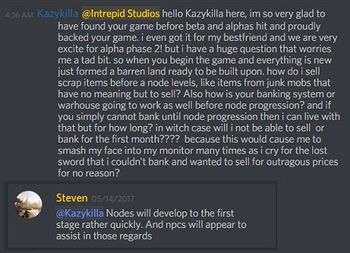
- ↑ Node series part II – the Metropolis.
- ↑ 56.0 56.1 Livestream, October 16, 2017 (50:20).
- ↑

- ↑

- ↑ Livestream, February 29, 2024 (53:58).
- ↑ 60.0 60.1 Interview, July 18, 2020 (10:04).
- ↑ 61.0 61.1 Interview, July 8, 2020 (1:00:15).
- ↑
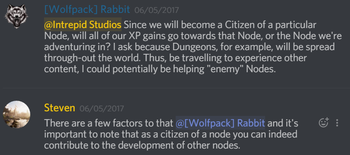
- ↑ Livestream, September 24, 2021 (1:21:23).
- ↑ 64.0 64.1 Livestream, May 26, 2017 (28:16).
- ↑ 65.0 65.1 65.2 65.3 65.4 Livestream, October 14, 2022 (55:13).
- ↑ Livestream, November 17, 2017 (55:27).
- ↑ Blog - Know Your Nodes - The Basics.
- ↑ 68.0 68.1 68.2 Livestream, October 30, 2020 (39:17).
- ↑ 69.0 69.1 69.2 69.3 69.4 69.5 Livestream, September 27, 2018 (53:06).
- ↑ 70.0 70.1 Livestream, February 25, 2022 (41:00).
- ↑ 71.0 71.1 Livestream, February 26, 2021 (1:12:18).
- ↑ Livestream, March 31, 2022 (4:57).
- ↑ Podcast, April 11, 2021 (29:47).
- ↑ Interview, May 11, 2018 (54:34).
- ↑ Livestream, May 26, 2017 (21:23).
- ↑ Podcast, April 11, 2021 (23:36).
- ↑ 77.0 77.1 Interview, May 11, 2018 (47:27).
- ↑ 78.0 78.1 Livestream, July 29, 2022 (1:13:09).
- ↑ 79.00 79.01 79.02 79.03 79.04 79.05 79.06 79.07 79.08 79.09 79.10 79.11 Livestream, September 27, 2018 (55:39).
- ↑ 80.0 80.1 80.2 Livestream, May 19, 2017 (22:10).
- ↑ 81.0 81.1 Interview, July 19, 2020 (36:07).
- ↑

- ↑ Livestream, June 26, 2020 (1:31:53).
- ↑ 84.0 84.1 Livestream, May 5, 2017 (23:26).
- ↑ Interview, August 8, 2018 (9:36).
- ↑ Livestream, October 30, 2020 (1:11:13).
- ↑ 87.0 87.1 87.2 Livestream, May 17, 2017 (7:27).
- ↑ Livestream, September 29, 2023 (1:07:50).
- ↑ Interview, July 19, 2020 (24:34).
- ↑ 90.0 90.1 90.2 90.3 Podcast, May 11, 2018 (18:52).
